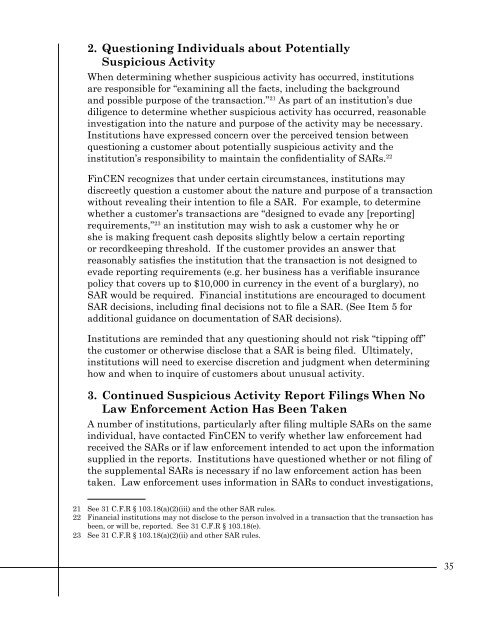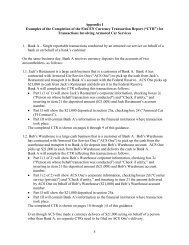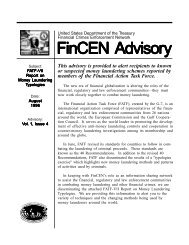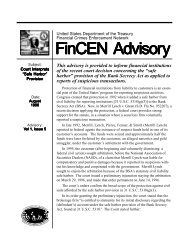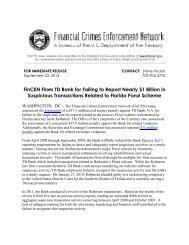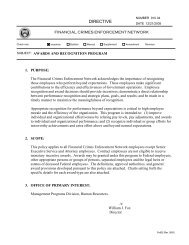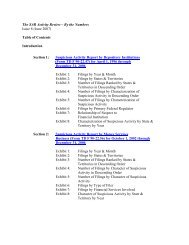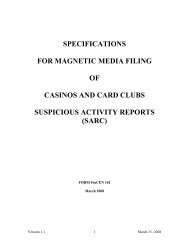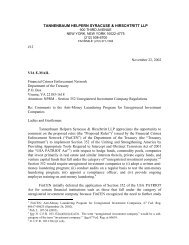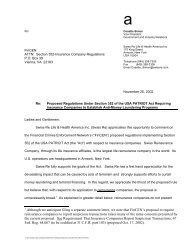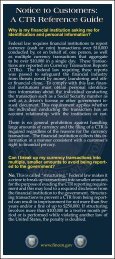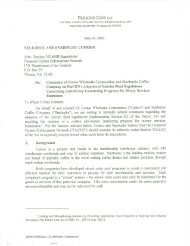FinCEN SAR Activity Review, Trends, Tips & Issues, Issue 10
FinCEN SAR Activity Review, Trends, Tips & Issues, Issue 10
FinCEN SAR Activity Review, Trends, Tips & Issues, Issue 10
You also want an ePaper? Increase the reach of your titles
YUMPU automatically turns print PDFs into web optimized ePapers that Google loves.
2. Questioning Individuals about Potentially<br />
Suspicious <strong>Activity</strong><br />
When determining whether suspicious activity has occurred, institutions<br />
are responsible for “examining all the facts, including the background<br />
and possible purpose of the transaction.” 21 As part of an institution’s due<br />
diligence to determine whether suspicious activity has occurred, reasonable<br />
investigation into the nature and purpose of the activity may be necessary.<br />
Institutions have expressed concern over the perceived tension between<br />
questioning a customer about potentially suspicious activity and the<br />
institution’s responsibility to maintain the confidentiality of <strong>SAR</strong>s. 22<br />
<strong>FinCEN</strong> recognizes that under certain circumstances, institutions may<br />
discreetly question a customer about the nature and purpose of a transaction<br />
without revealing their intention to file a <strong>SAR</strong>. For example, to determine<br />
whether a customer’s transactions are “designed to evade any [reporting]<br />
requirements,” 23 an institution may wish to ask a customer why he or<br />
she is making frequent cash deposits slightly below a certain reporting<br />
or recordkeeping threshold. If the customer provides an answer that<br />
reasonably satisfies the institution that the transaction is not designed to<br />
evade reporting requirements (e.g. her business has a verifiable insurance<br />
policy that covers up to $<strong>10</strong>,000 in currency in the event of a burglary), no<br />
<strong>SAR</strong> would be required. Financial institutions are encouraged to document<br />
<strong>SAR</strong> decisions, including final decisions not to file a <strong>SAR</strong>. (See Item 5 for<br />
additional guidance on documentation of <strong>SAR</strong> decisions).<br />
Institutions are reminded that any questioning should not risk “tipping off”<br />
the customer or otherwise disclose that a <strong>SAR</strong> is being filed. Ultimately,<br />
institutions will need to exercise discretion and judgment when determining<br />
how and when to inquire of customers about unusual activity.<br />
3. Continued Suspicious <strong>Activity</strong> Report Filings When No<br />
Law Enforcement Action Has Been Taken<br />
A number of institutions, particularly after filing multiple <strong>SAR</strong>s on the same<br />
individual, have contacted <strong>FinCEN</strong> to verify whether law enforcement had<br />
received the <strong>SAR</strong>s or if law enforcement intended to act upon the information<br />
supplied in the reports. Institutions have questioned whether or not filing of<br />
the supplemental <strong>SAR</strong>s is necessary if no law enforcement action has been<br />
taken. Law enforcement uses information in <strong>SAR</strong>s to conduct investigations,<br />
21 See 31 C.F.R § <strong>10</strong>3.18(a)(2)(iii) and the other <strong>SAR</strong> rules.<br />
22 Financial institutions may not disclose to the person involved in a transaction that the transaction has<br />
been, or will be, reported. See 31 C.F.R § <strong>10</strong>3.18(e).<br />
23 See 31 C.F.R § <strong>10</strong>3.18(a)(2)(ii) and other <strong>SAR</strong> rules.<br />
35


